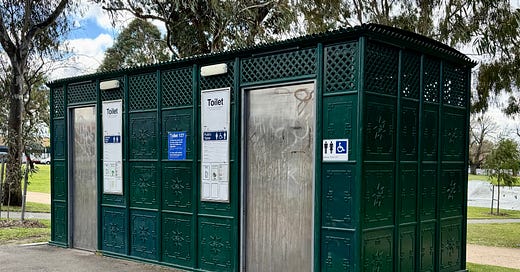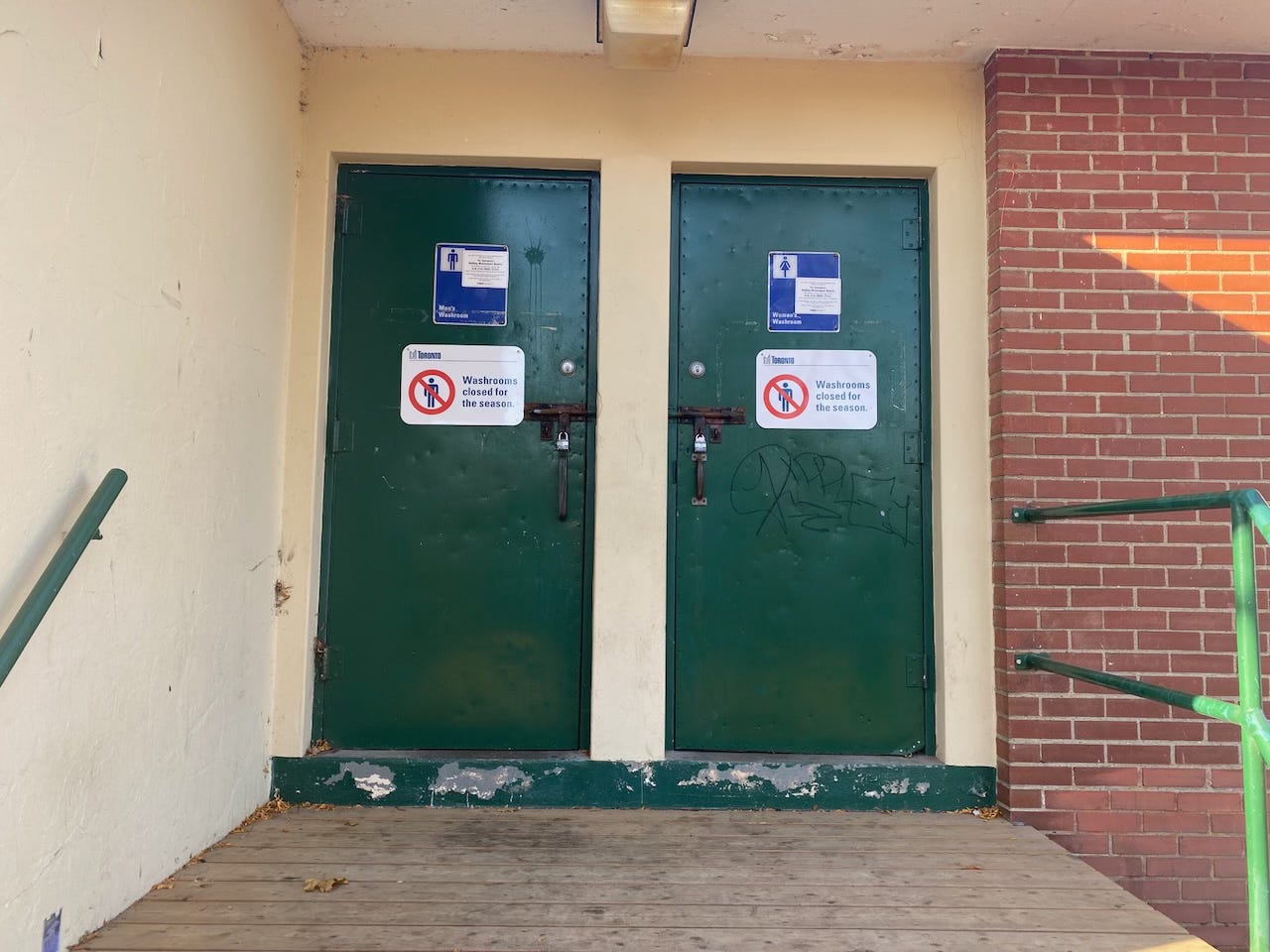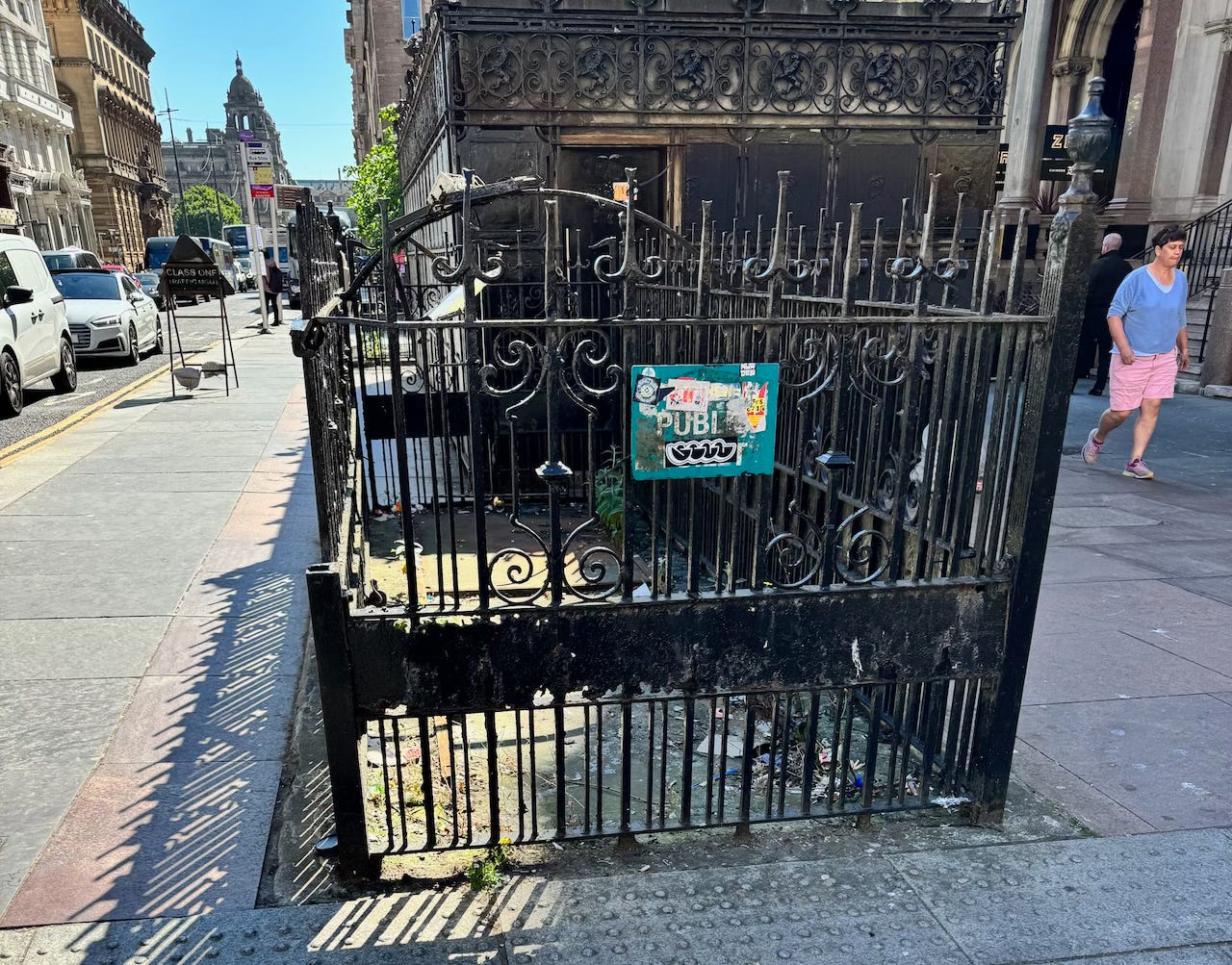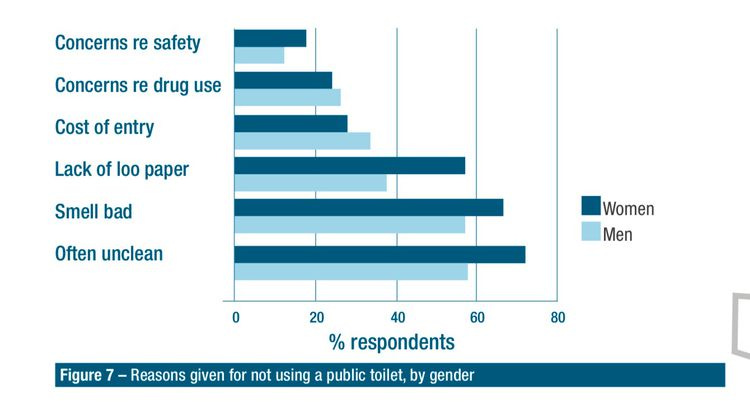"Loo Leash"- the distance one can be from a toilet- affects people of every age.
I have described this as a boomer problem, but it is much bigger than that.
I loved visiting Melbourne, Australia last fall, but my digestive system didn’t; I needed to find a toilet many times during my day while walking there. Fortunately, there was a network of them, many made of prefabricated cast iron. They have been around for a while;
“Cast by C. Monteath & Sons, an iron foundry in South Melbourne between 1903 and 1918, there were originally 40 of these toilets which employed a prefabricated interlocking post-and-panel system that allowed them to be easily assembled and disassembled on site. As well as being functional, they were quite ornate by today’s standards.”
Toronto, where I live, is not so lucky; public toilets are few and far between, and often only open seasonally. The Globe and Mail editorializes that this is a problem for parents with children:
“Children tend to have a short “bladder’s leash,” how physically distant a person can be from a toilet while still being able to get to a facility in time of need. When kids need to go, they need to go now. The leash is also short for many seniors, pregnant women or those with intestinal conditions. While the leash may be longer for other people, it is still there.”
I have written about this often, usually focusing on the big and growing cohort of men with big and growing prostates. The Globe is right to note that there is a much larger constituency of people who need to go.
The Globe editors have a sophisticated view of urban density, which “nourishes the arts and seeds commerce. It supports the sort of local merchants that let people live more of their life in convenient proximity. It makes mass transit work.” But density creates urban obligations:
“Density, in turn, requires great public spaces. Urban parks, squares and waterfront promenades are a sort of backyard for millions of city residents. To enjoy these spaces they need to be able to satisfy the basic functions of life. At the very least, they need places to sit, a way to quench their thirst and somewhere to relieve themselves.”
In fact, a basic function of the state is the supply of clean water and the removal of sewage and human waste, but they have been relegated to the private realm, connected to private buildings; in the public realm, the water fountain and the public toilet have virtually disappeared. The Globe concludes:
“People can’t live a full life when bound by a short bladder’s leash. Build the toilets that will let them roam freely, and transform cities into leash-free zones.”
The leash analogy is not new. A few years ago I wrote about a British study concluding Public Washrooms Are "As Essential as Streetlights"
"Loo Leash" sometimes also called a ‘urinary leash,’ refers to being unable to stray far from home, in case no toilet can be found. Two in five (42%) respondents reported that they have restricted outings on this basis, including 4% who have to do this more than once a week.
.The study found that 85 percent said that local governments should have “a legal responsibility to provide public toilets which are free to use for the public” – but only 34 percent thought they should pay more taxes to cover the cost. The authors concluded:
“Public toilets should be considered as essential as streetlights, roads and waste collection, and equally well enforced by legislation and regulations. The lack of provision is affecting equality, mobility, physical fitness and other aspects of health. However, our survey also demonstrated a central problem – no one wants to pay for them.”
This is the problem in Toronto; building and maintaining modern toilets is expensive. We tend to rely on restaurants and malls, many of which are closing. As noted earlier this year, Starbucks is no longer going to be “America’s bathroom;” In Canada we don’t even have the Hudson’s Bay Company stores’ lovely loos anymore.
But in a province with tens of billions to spend on underground highways, surely we can find a few million for public loos. I wrote years ago:
The situation is only going to get worse as the population ages (baby boomer men have to pee a lot), but there are also people with irritable bowel syndrome, pregnant women and others who simply need a bathroom more often or at less convenient moments. Authorities say providing public washrooms can't be done because it would cost "hundreds of millions" but never have a problem spending billions on the building of highways for the convenience of drivers who can drive from home to the mall where there are lots of washrooms. The comfort of people who walk, people who are old, people who are poor or sick — that doesn't matter.
Public washrooms really are just as important as public roads because, in both cases, people gotta go.
Jon Lorinc wrote a great series about Toronto washrooms and the lack thereof for Spacing: Why we can’t go
Special offer!
I do not want to put up a paywall on this site, but it provides a meaningful portion of my income. So here’s a limited time offer: I will send a signed copy of the print edition of “Living the 1.5 Lifestyle” to anyone in the USA or Canada who signs up for a one-year subscription (C$50, cheap at about US$34.95 )








Winnipeg has an even bigger problem with this, as I have hardly seen any such things around town for years. We used to have a fairly sizable one near Memorial Park in the downtown era, but it got torn down because it was attracting a bad class of people doing things unrelated to bodily functions within it.
thank you for writing about this. the “loo leash” keeps me from some protests. i have a rare-ish condition called “diabetes insipidus”. the condition means that my kidneys don’t receive the signal to conserve water and electrolytes. basically i urinate more than i can replace, and need to pee every 1-2 hours. o never sleep through the night. ever.
going out in the heat causes that to ramp up in effect. i need at least 32 ounces of diluted electrolyte drink for every hour i’m outdoors. even when i’m at home i drink almost a gallon of water a day. we don’t have public restrooms here except in parks for kids. that’s great for them but doesn’t help me when i’ve consumed a half gallon of water and need to excrete it and am downtown with a protest sign.
i curse my parents every day for breeding and passing on this hellish condition for which there is no good diagnosis or treatment.
protests rarely occur in places with toilets, or the toilets are too far to walk to.